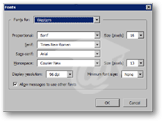Mozilla Thunderbird's Display Options: Fonts
 To access Thunderbird's Options dialog and modify its settings, go to Tools > Options, click the desired topic and select the appropriate tab, as applicable.
To access Thunderbird's Options dialog and modify its settings, go to Tools > Options, click the desired topic and select the appropriate tab, as applicable.
For Thunderbird's Display options outside the Fonts tab, please see the Display Options tutorial.
Fonts in Thunderbird
The Fonts tab in Thunderbird's Options dialog lets you determine your font preferences, and more generally how fonts are handled in Thunderbird.
 To Configure the fonts used by Thunderbird, click the Fonts button, the Fonts dialog should open.
To Configure the fonts used by Thunderbird, click the Fonts button, the Fonts dialog should open.
The first drop-down menu shows your default settings, Western if your operating system default is latin alphabet. Thunderbird lets you edit settings for multiple character encodings, which is useful if say, you send and receive emails in multiple languages, some of which do not use the same alphabet as the others.
Character Encoding is the way Windows (and other operating systems) treat text content. The default for Latin alphabet languages (like English, French, Romanian…) is Western ISO-8859.
The International Organization for Standardization  is an organization that standardizes technologies to ensure that vendors' products (even competing ones) can communicate with each other.
is an organization that standardizes technologies to ensure that vendors' products (even competing ones) can communicate with each other.
Overview of Font Families
There are three main font families: serif, sans-serif, and monospace. Often, serif and sans-serif are referred to as Variable-width fonts, while monospace fonts are also called Fixed-width fonts.
On Windows and Mac systems, the default serif font is respectively Times New Roman and Times. Sans-serif usually is defaulted to respectively Arial and Geneva on Windows and Mac. Monospace fonts usually appear as Courier New (Windows) or Courier (Mac).
Serif, variable-width:
The Quick Brown Fox Jumps Over The Lazy Dog.
Sans-serif, variable-width:
The Quick Brown Fox Jumps Over The Lazy Dog.
Monospace, fixed-width:
The Quick Brown Fox Jumps Over The Lazy Dog.
 A serif font is distinguishable by embellishments at the end of the letter's strokes. In French, Sans means Without: a sans-serif font does not have serifs.
A serif font is distinguishable by embellishments at the end of the letter's strokes. In French, Sans means Without: a sans-serif font does not have serifs.
Fixed-width ("monospace") fonts are called that way, because each character has the same width, unlike a variable-width font in which for example the letter "i" is narrower than the letter "m".
Thunderbird's Fonts Settings
With the Proportional drop-down menu, Thunderbird allows you to choose between a serif or a sans-serif font to represent variable-width ("proportional") fonts, and which size to use by default.
 While Thunderbird follows your operating system's default in representing types of font families, it gives you the option to change them, as well as the default font size.
While Thunderbird follows your operating system's default in representing types of font families, it gives you the option to change them, as well as the default font size.
Pixel is a variable unit determined by the smallest point that can be display by your computer's monitor. Pixels are called a variable unit because the monitor's size and resolution determine the actual (absolute) proportions of a pixel. The white dot below is a 1x1 pixel square.![]()
 Thunderbird allows you to customize the resolution of your emails' font. The Display Resolution drop-down menu is set by default to 96 dpi, and offers alternate choices of 72 dpi or "Custom".
Thunderbird allows you to customize the resolution of your emails' font. The Display Resolution drop-down menu is set by default to 96 dpi, and offers alternate choices of 72 dpi or "Custom".
DPI stands for Dots Per Inch, and measures the resolution quality of an output, whether digital or printed. 72 dpi is generally accepted as the norm for digital media, while 300 dpi is the minimal resolution for high-quality, commercial printing.
Thunderbird also allows you to force fonts to be at least a certain size, from 9 pixels to 24 pixels. By default, Thunderbird does not enforce a minimal font size, ("None").
 Finally, you can restrict your emails' font face to the three font-families described above. By default, Thunderbird lets emails determine that.
Finally, you can restrict your emails' font face to the three font-families described above. By default, Thunderbird lets emails determine that.
Character Encodings
 Thunderbird lets you enforce character encoding defaults for incoming and outgoing emails.
Thunderbird lets you enforce character encoding defaults for incoming and outgoing emails.
Western ISO-8859-1 should be the default preselections if your operating system uses the latin alphabet. By default, character encoding for outgoing emails follows your operating system's default, and character encoding for outgoing emails should follow the incoming email's character encoding.
You can ask Thunderbird to override these settings by applying your default character encoding to both incoming and outgoing emails. You should not change Thunderbird's default behavior unless you know that you will never receive emails from a character encoding different from yours. This is hard to know in advance, and will likely cause problems in case you do get emails of another character encoding.
Our recommendation is not to ask Thunderbird to enforce anything regardless of the email.